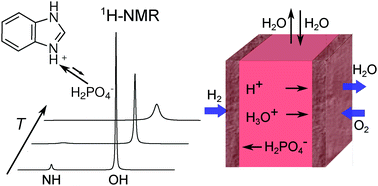Why do proton conducting polybenzimidazole phosphoric acid membranes perform well in high-temperature PEM fuel cells?†
Abstract
Transport properties and hydration behavior of phosphoric acid/(benz)imidazole mixtures are investigated by diverse NMR techniques, thermogravimetric analysis (TGA) and conductivity measurements. The monomeric systems can serve as models for phosphoric acid/poly-benzimidazole membranes which are known for their exceptional performance in high temperature PEM fuel cells. 1H- and 31P-NMR data show benzimidazole acting as a strong Brønsted base with respect to neat phosphoric acid. Since benzimidazole's nitrogens are fully protonated with a low rate for proton exchange with phosphate species, proton diffusion and conduction processes must take place within the hydrogen bond network of phosphoric acid only. The proton exchange dynamics between phosphate and benzimidazole species pass through the intermediate exchange regime (with respect to NMR line separations) with exchange times being close to typical diffusion times chosen in PFG-NMR diffusion measurements (ms regime). The resulting effects, as described by the Kärger equation, are included into the evaluation of PFG-NMR data for obtaining precise proton diffusion coefficients. The highly reduced proton diffusion coefficient within the phosphoric acid part of the model systems compared to neat phosphoric acid is suggested to be the immediate consequence of proton subtraction from phosphoric acid. This reduces hydrogen bond network frustration (imbalance of the number of proton donors and acceptors) and therefore also the rate of structural proton diffusion, phosphoric acid's acidity and hygroscopicity. Reduced water uptake, shown by TGA, goes along with reduced electroosmotic water drag which is suggested to be the reason for PBI–phosphoric acid membranes performing better in fuel cells than other phosphoric-acid-containing electrolytes with higher protonic conductivity.


 Please wait while we load your content...
Please wait while we load your content...